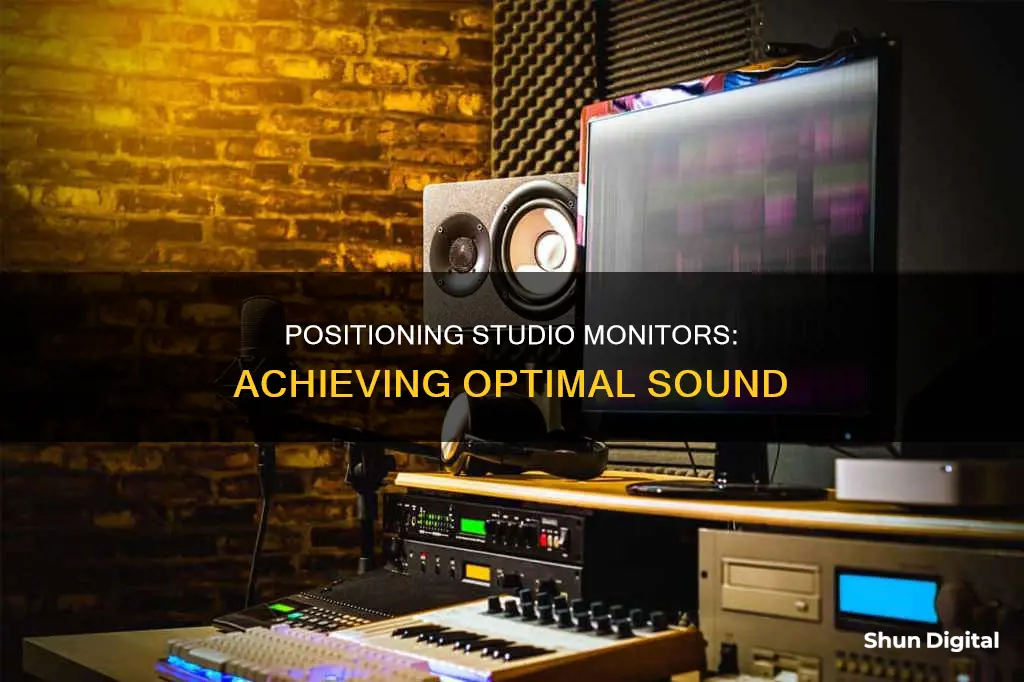
Studio monitor placement is a crucial aspect of setting up a home recording studio. The position of the monitors can significantly impact the sound quality and listening experience. The goal is to achieve a balanced and non-distorted sound by considering factors such as room selection, monitor distance, angle, and height. Here are some key guidelines to help you position your studio monitors optimally:
- Room Selection: Choose a room with minimal windows, clutter, and square shapes. Tall ceilings, non-divisible dimensions, and padded walls are ideal. Avoid carpeted floors and external noise interference.
- Monitor Distance: Place the monitors at an appropriate distance from the listener, typically following the equilateral triangle principle. Avoid placing them too close to walls or in corners to prevent bass buildup and anomalies in the low-end frequency spectrum.
- Angle and Height: Ensure the monitors are angled towards the listening position, forming an equilateral triangle with the listener's head. Adjust the height so that the tweeters are at ear level.
- Symmetry: Strive for symmetry in the room setup, including monitor placement and acoustic treatment. This helps create a consistent and accurate stereo image.
- Acoustic Treatment: Consider adding bass traps, acoustic panels, and diffusion to the rear wall to minimize standing waves and improve sound quality.
| Characteristics | Values |
|---|---|
| Room shape | Rectangular, not square |
| Room size | Bigger is better |
| Room dimensions | Not divisible by the same number or by each other |
| Windows | Few or none |
| Clutter | None |
| Ceiling height | Tall |
| Flooring | Concrete or hardwood, not carpet |
| Noise | Quiet area with minimal outside noise |
| Monitors from the wall | 2-3 feet, or as far as possible |
| Monitors from each other | Form an equilateral triangle with the listener's head |
| Monitors height | Ear height, or slightly above |
| Monitors angle | Pointed towards the listener's ears |
What You'll Learn

Choose a room with no windows, tall ceilings, and no clutter
When setting up a studio, the room you choose can have a significant impact on the sound quality. Opting for a room with no windows, tall ceilings, and no clutter is ideal for achieving the best acoustics.
Windows and openings can disrupt the clean sound you are aiming for, as they introduce variables that affect the already complex positioning process. By selecting a room with no windows, you eliminate the potential for unwanted sound reflections and interference. This ensures that the sound produced by your studio monitors remains consistent and unaffected by external factors.
Tall ceilings are advantageous as they prevent sound waves from bouncing off low surfaces and causing distortions. In rooms with low ceilings, sound waves may not reach you properly, resulting in a compromised listening experience. By choosing a room with ample vertical space, you minimise the chances of sound interference and create a more conducive environment for accurate sound engineering.
Clutter, such as furniture, toys, or any other objects, can negatively impact sound production. These extra surfaces can disrupt the path of sound waves, causing reflections and distortions. A room with minimal clutter ensures that sound waves travel more freely and accurately, allowing you to capture the true quality of your music without unwanted interferences.
By choosing a room with no windows, tall ceilings, and no clutter, you are taking important steps towards achieving optimal sound quality in your studio. This combination of factors helps to create a controlled environment where sound waves can travel efficiently, minimising the chances of unwanted reflections and distortions. Remember, the goal is to create a space that enhances your listening experience and allows you to make accurate adjustments to your music production.
Blind Spot Monitor Standardization in Hyundai Santa Fe Models
You may want to see also

Position your monitors along the long wall
If you have an average to large room, the best place to put your monitors is on the long wall. This is because, in a rectangular room, the long wall is the narrow end of the room's axis, and it is best to fire down the longest axis of the room.
Your position should never exceed halfway across the room's length since it can cause standing waves. This is why smaller rooms tend to do well with the short (wide) wall area, as it gives you more wiggle room.
No matter which wall you choose, you will need to place your overall setup in the centre of that wall. This helps keep the symmetry of the soundwaves, which improves the sound quality and keeps your listening balanced.
The biggest issue with keeping monitors on walls is the way they exaggerate low-frequency notes. This is a primary reason people overestimate their bass levels, and it could be avoided by just not hanging your monitors on a wall.
For the majority of home studios, the best distance to place monitors is approximately two to three feet away from the wall. This decreases the amount of bass buildup, giving you a way cleaner sound that lets you hear all the details.
Obviously, this isn’t always doable in smaller studio rooms. The best way to position your monitors is to place them as far as you feasibly can. If a foot is all you can do, just place them a foot away.
If you can’t avoid being near a wall, some speakers have built-in settings to try and counteract the issues caused by your room. For example, the Yamaha HS series has ‘room control’ and ‘high-trim’ settings which will allow you to attempt to counteract some of the unwanted frequencies generated by being close to a wall.
A good trick is to play a song you know really well and adjust accordingly.
Mumbai's Best Monitor Retailers: A Comprehensive Guide
You may want to see also

Place monitors at ear level
To get the best sound quality from your studio monitors, it is important to place them at ear level. This is because soundwaves are very directionally influenced, and the way they move can be influenced by your position.
The ideal setup is to have your studio monitors at the same height as your ears, facing you directly. This ensures the sound is focused on you and that you don't get extra noise. This setup also means you don't have to tilt your monitors up or down, and you can keep them parallel to the ground.
If you are using ITU Standard Monitors, these should be positioned anywhere from 47 to 55 inches from the ground, at ear level, and never tilted more than 15 degrees from the ground. If you are using Main Monitors, the main monitor should be placed in between the two tweeters, at a slightly higher level—most pro spaces place these monitors 58 inches off the floor.
If your studio monitors are on a desk, you will likely need to raise them or angle them so that their perpendicular axis points upwards towards your head. You can do this with monitor stands, which also help to decouple the speakers from the surface of the desk, reducing early reflections. Desktop speaker stands also often allow you to angle the speakers slightly, helping you to get the height right.
If you are unable to get your studio monitors to ear level, you should angle them so that they are pointing directly at your ears.
Choosing the Right Monitor Size for Classrooms
You may want to see also

Avoid placing monitors near hard, reflective surfaces
When setting up studio monitors, it is important to avoid placing them near hard, reflective surfaces. This is because such surfaces can cause anomalies in the low end of the frequency spectrum, distorting the sound and making it less reliable.
Acoustically hard surfaces reflect sound in the same way that a mirror reflects light. When the direct sound from a speaker combines with a reflected sound, the sound is altered, a phenomenon known as "comb filtering". Windows, drywall or plaster walls, mirrors, and any non-absorptive, non-diffusible surfaces are all examples of hard surfaces that can cause this issue.
To avoid reflections from nearby hard surfaces, it is recommended to position studio monitors away from walls, particularly corners, as these can boost bass frequencies and cause sound distortion. A good rule of thumb is to maintain a distance of at least one to two feet between the monitors and the rear wall, with the monitors facing away from the wall.
In addition to the rear wall, side walls can also impact sound reflection. It is beneficial to maximise the distance between the monitors and the side walls to minimise reflections. It is also important to ensure that the distance from each side wall to the listening position is similar, creating symmetry and reducing imbalances in the stereo field.
Another way to minimise reflections from hard surfaces is to use acoustic treatment, such as bass traps or acoustic panels, placed behind and around the monitors. This can help absorb and diffuse sound, reducing the impact of reflections on the overall sound quality.
By following these guidelines and avoiding the placement of studio monitors near hard, reflective surfaces, you can improve the accuracy and quality of your sound setup.
Ultimate Monitor Size for the Nintendo Unisystem Arcade
You may want to see also

Adjust the monitors to sound correct
Now that you've set up your studio monitors, you'll want to make sure they sound right. A good way to do this is to listen to music that you know sounds great on lots of systems and see if it sounds great on your speakers. If not, move your speakers around until they sound closer to what you know the music should sound like.
If there is too much bass, move the speakers away from walls and corners, which will reduce the low end. If there are adjustments on the speakers (such as high-frequency boost/cut, low-frequency boost/cut, low-frequency roll-off, etc.), adjust those until the speakers sound "right" to you.
The point is to have your mixes translate into the real world, so adjust your speakers until they sound like what you end up hearing outside the studio. That way, you'll have a better chance of getting mixes that sound good on the majority of systems.
A good trick is to play a song you know really well and adjust accordingly.
How LCD Monitors Use Diffusers to Display Images
You may want to see also
Frequently asked questions
Choose a room with tall ceilings, no windows, and minimal clutter. The room's dimensions should not be divisible by the same number or by each other to minimise reverberation and echo.
The ideal setup is for your head and the two monitors to form an equilateral triangle, with the monitors angled towards your head. You should be positioned at least 3 feet away from large, professional-grade monitors to avoid hearing damage.
The distance between the monitors should be the same as the distance from each monitor to your ears. For example, if you are listening at a distance of 2 metres, there should be 2 metres between your left ear and the left monitor, and the same for the right side.
The monitors should be positioned at ear height so that you are facing the speakers directly. This ensures you get the most consistent and best sound.
Position the monitors against the longest wall to minimise issues from side reflections. Vary the distances between the monitors and each wall to avoid creating standing waves. Add bass traps and acoustic panels to the room to absorb sound reflections.







